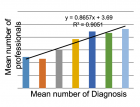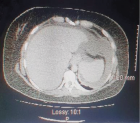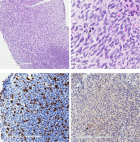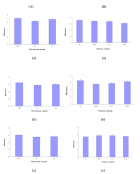Table of Contents
Natural infection of squash fruits (Cucurbita pepo) by Zucchini Yellow Mosaic potyvirus (ZYMV) in Alexandria governorate
Published on: 20th April, 2020
OCLC Number/Unique Identifier: 8586051082
An isolate of zucchini yellow mosaic virus (ZYMV) was obtained from naturally infected squash fruits were grown in Abees region, Alexandria governorate. Disease symptoms were Showing mosaic, yellowing and blistering and absis symptoms. The identification was based on the symptoms developed on diagnostic hosts and serological reactions with antisera to cucumber mosaic cucumovirus (CMV), watermelon mosaic potyvirus 2 (WMV-2) and ZYMV. Squash fruit isolate of ZYMV was transmitted by Aphis gossypii, Aphis neri and Myzus persicae in non-persistent manner. The virus was purified by ultra-centrifugation and PEG. The purified virus had an ultraviolet absorption spectrum typical of a nucleoprotein with A260/280 and A280/260 being 1.1 and 0.91 respectively. The yield of purified virus was 1.62 mg/100g infected leaf tissues. Specific antiserum was prepared and found to have a titer of 1:409600 as determined by indirect ELISA.
Role of pollen morphology in taxonomy and detection of adulterations in crud drugs
Published on: 2nd April, 2020
OCLC Number/Unique Identifier: 8577732918
Present paper communicates 42 species of angiosperms depicting characteristics of pollen grains as shape, color, exine ornamentations, and type of apertures. Pollen morphological characters are very important in plant identifications in field. Pollen surface features plays significant role in taxonomy and detection of crud drugs. Firsthand information is gathered from field and provided in this research article.
Analysis of factors influencing participation of farm households in watermelon production in some selected local government areas of Sokoto State, Nigeria
Published on: 28th February, 2020
OCLC Number/Unique Identifier: 8930822971
The study analyzed the factors influencing participation of farm households’ in watermelon production in the study areas. Three local government areas out of Sokoto state were purposively selected. Questionnaire was used to collect data. Multistage of sampling techniques were used to arrive at the sample size of 181 farm households’ for the study. Likert scale is used to analyze the level of participation of farm households’, frequency and inferential statistics were used to analyze the data. The findings revealed that (55.8%) of the farm households are within the ages of 25-30 years, majority (96.7%) are male It shows that majority (64.0%) of the farm households participated in watermelon production as a result of higher income generated. Multiple regression analysis result revealed significant relationships between farm household’s participation in watermelon production and their socio-economic characteristics at p < 0.05. The constraints faced by the farm households are storage technology and improved agricultural inputs. Most (63.5%) of the farm households believed that provision of subsidized agricultural inputs and market accessibility are forms of assistance that will encourages farm households to partake in watermelon production. It is recommended that government and donor agencies should encourage farm households’ by providing them with the modern agricultural inputs so as to influence them to participate fully into watermelon production irrespective of their Socio-economic differences.
The Importance of Potato virus Y Potyvirus
Published on: 19th February, 2020
OCLC Number/Unique Identifier: 8930826479
Potato virus Y Potyvirus (PVY) is one of the most important aphid transmitted viral pathogen of potato worldwide. PVY affects potato plant (Solanum tuberosum L.), which is an important economic crop. PVY infection with potato viruses usually causing severe economic damage affecting both tubers quality and trade. PVY can degrease the production of certified seed and also crops grown for processing or fresh market. Potato is considered as one of the most economically important solanaceous crops cultivated in different regions that (PVY) has been studied in many parts of the world. Wide host plant range is a characteristic of viruses belonging to the Potyviridae. 495 species in 72 genera of 31 families were reported to be infected by PVY. Under field conditions, potato plants are subjected to attack by many viruses. The most cited virus could affect potato in the world is PVY. It has been long recognized as a threat to potato cultivation. Several studies carried out and reported that PVY is the most important virus infecting potato in different localities. Our review article is showed that PVY are the most frequently detected viruses in potato.
In vitro and preventative field evaluations of potential biological control agents and synthetic fungicides for control of Clarireedia jacksonii sp. nov.
Published on: 6th February, 2020
OCLC Number/Unique Identifier: 8537104274
Clarireedia jacksonii sp. nov. Formerly Sclerotinia homoeocarpa F.T. Bennett, the causal agent of dollar spot (DS), is the most destructive pathogen in turfgrass. Symptoms appear as circular patches 10-40 mm in diameter with small tan lesions surrounded by a darker band, sometimes presenting an hour glass appearance. A multi-year study was initiated with the objective of determining the efficacy of biological control agents (BCA) and tank mixes of BCA’s and synthetic fungicides on DS control. Nutrient source was also evaluated to determine any interaction with the BCA’s and tank mixes. in vitro studies evaluated the efficacy of synthetic and BCA’s for C. jacksonii control. Quarter strength potato dextrose agar was amended with ¼, ½ and full labeled rates of various products. Chlorothalonil at all rates provided greatest (> 90%) control of C. jacksonii for study duration. Biological control agents provided best efficacy at ¼ and ½ label rates. Streptomyces griseoviridis provided least efficacy and may have exacerbated formation of C. jacksonii. Preventative field evaluations for synthetic and BCA’s provided different results between two study years. In Year 1, all treatments had < 15% disease severity for the duration of the study. In year 2, disease pressure was extremely elevated. Synthetic program 1, centered on azoxystrobin + propiconazole applications and conventional fertility sources, provided best results with < 5% disease severity for the duration of the study. Reduced synthetic program 1, and synthetic program 2 followed closely with < 10% disease severity. Reduced synthetic programs were based on monthly applications of either chlorothalonil or pyraclostrobin every 30 day, alternated with biofungicide applications. Synthetic program 2 utilized rotation applications of pyraclostrobin and chlorothalonil every 14 days. Organic programs, utilizing only biofungicides and organic fertility sources, provided the least amount of control and exceeded the 15% threshold by the second month of the evaluation period.

HSPI: We're glad you're here. Please click "create a new Query" if you are a new visitor to our website and need further information from us.
If you are already a member of our network and need to keep track of any developments regarding a question you have already submitted, click "take me to my Query."


























































































































































